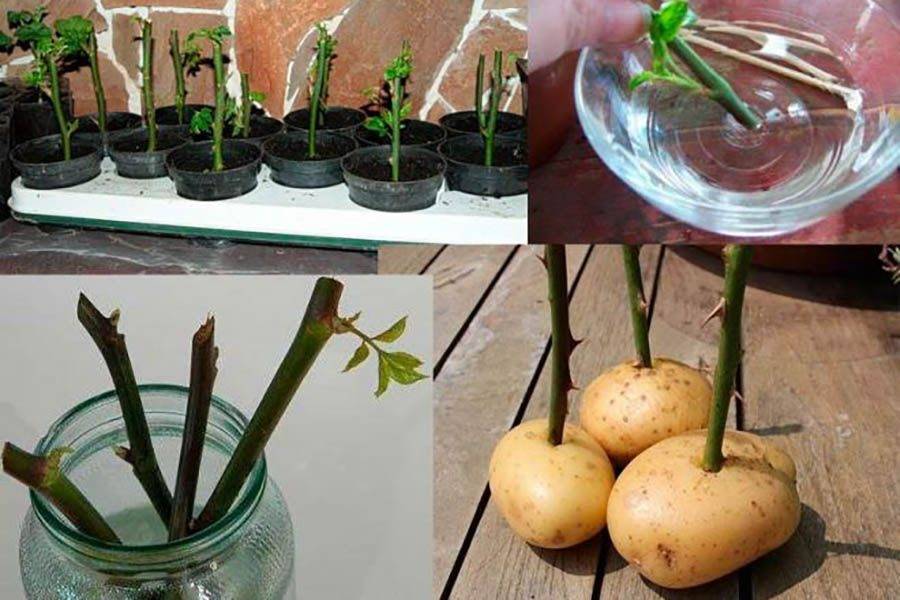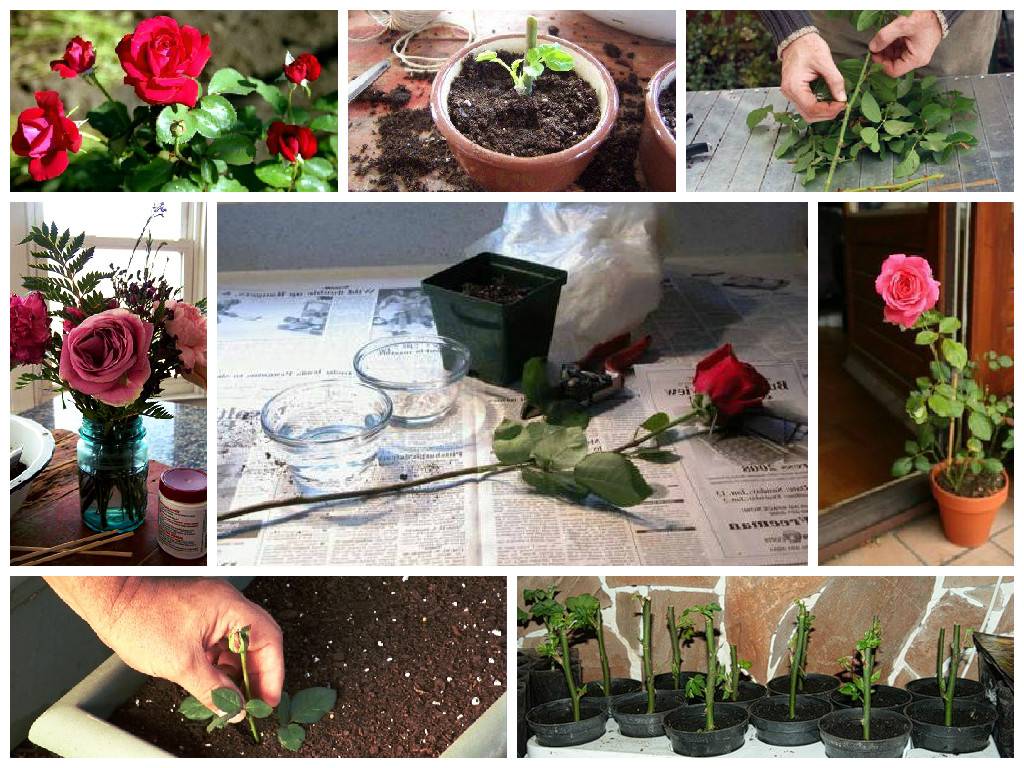How to root a rose from a bouquet at home
Content:
Surely, most women at least once in their lives thought about growing a rose from a bouquet. Florists have long invented quite effective options for reproduction of the flowers they like, received as a gift. Knowing them, you can preserve a living memory in the form of a plant in a pot in your window or in your garden.
Rooting bouquet roses
To root a rose from a bouquet at home, a number of grafting methods are used, in which part of the stem becomes a full-fledged seedling. With the correct procedures, such a stalk will not yield to store planting material.
Not every rose can be propagated. The selected copy must be produced as close as possible to the place of purchase. This gives hope that the flower has undergone minimal chemical treatment in order to preserve its presentation. Flowers used for rooting must be fresh. It will not work to sprout a rose from a withered bouquet, "so that the good does not disappear."
In addition to the proximity of the growing region and maximum freshness, there are a number of other factors that can hinder the reproduction of roses from a bouquet:
- The stems that have begun to lignify are preferable, and not too young or, on the contrary, overripe petioles.
- The petioles should have buds and live leaves.
- The rose should be in the vase without changing the water for no more than a day.
- It is advisable to manipulate flowers cut in the spring and summer. Germination in the fall and winter is rarely successful.
Also, experts say that the color of the rose matters - it is better if it is red or pink. Yellow and orange varieties will take less root, and propagating a plant with white buds is the most difficult task.
Cutting bouquet roses
Everyone can learn how to root a rose from a bouquet at home. First you need to master the technique of cutting flowers and, having chosen the most accessible method, root the resulting segments of the stems.
Rooting roses
In order to properly cut bouquet roses, the following procedure is required:
- Take a sharpened knife or secateurs.
- Disinfect the instrument.
- Remove flowers.
- Cut the stems into 15 cm cuttings so that the cut under the lower bud is oblique, and above the upper one exactly horizontal. As a result, two or three buds should remain, which will become new shoots.
- The leaves located in the upper part of the cutting should be shortened by a third part, and the lower ones should be completely removed.
Rooting methods
After the cuttings of roses from the bouquet are prepared, it will not be difficult to plant them. You can root them directly in the ground. There are also ways to achieve root formation through aging in water, potatoes, using aloe, and even using material such as newspaper.
Rooting in water
This is a fairly simple and not laborious method of germinating and propagating bush roses.
Using it, the stalk is lowered with a pointed end into water, where crushed charcoal has been added. The water should be changed twice a day for about a month, until the roots that have appeared are sufficiently strong and prepared for planting in a permanent place.
Rooting cuttings in the ground
A seedling with strong roots can be obtained in this way, since the growing conditions are close to natural. The step-by-step sequence will be as follows:
- Take plastic cups or pots with a volume of 0.5 liters.
- The container is washed and wiped with a solution of potassium permanganate, after which it is thoroughly dried.
- A drainage layer and suitable soil (purchased or compiled independently from sheet earth, humus and sand) are poured into each planting tank.
- Shallow pits are made in the soil with a finger, into which the cuttings are placed. In this case, the upper kidney should be above the ground level.
- A layer of earth is tamped with hands and watered.
- Cover the cuttings with glass jars.
- Containers with planted cuttings are installed in a room where the daytime temperature is 25 ° C and does not drop below 18 ° C at night. The lighting should be bright, but it is better to shade the seedlings from direct sunlight. There should be no drafts.
- Cuttings are regularly watered and ventilated.
Rooting using potatoes
Reproduction in potato tubers makes it possible to provide cuttings with the necessary nutrients. For this, strong tubers are selected without signs of disease or other damage.
The potatoes are washed, rinsed with manganese and dried. Deep holes are pierced in the potato, into which the cuttings are inserted. After that, the tubers are placed in the ground and added dropwise.
Use of growth stimulants
Whichever method of rooting is chosen, for a more effective procedure, it is recommended to treat each of the cuttings with a growth stimulant. It is better to use store drugs that have shown themselves well. These include "Heteroauxin", "Epin", "Kornevin".
Dilute any of the formulations given here strictly in accordance with the instructions for the preparation. The cuttings are dipped into the solution by about 1/3 and kept in it for about 6 hours.
Further care of planted cuttings
After the cuttings grow roots, they continue to be kept in an apartment. It will be possible to transplant young plants into open ground only when the threat of frost has passed and the temperature indicator is established at a level above 0 degrees.
When and how to plant cuttings of bouquet roses in open ground
The most suitable time for moving rooted cuttings into the ground is late spring, when the last frost has passed. The site for planting roses is chosen protected from gusts of wind and sufficiently lit. It is better if it is a hill where groundwater does not reach the roots.
The planting hole is prepared with a diameter that exceeds the size of the root system. A drainage layer is poured onto the bottom and filled with nutritious soil. You can also add mineral dressings for flower crops. Shoots are made a little shorter if they managed to grow more than 4 buds. After completing the planting, the plants are watered and mulched.
After a couple of weeks, the plant will get used to the new place and begin to grow. You can feed the flower with a weak mullein solution or herbal infusion. In the first year of life, it is better not to let the plant bloom, removing the buds so that the young rose can grow stronger. By the winter period, each bush is covered with a layer of mulch and non-woven cloth.
Briefly about growing a rose at home
Having learned how to plant roses at home, you should familiarize yourself with the usual care requirements for this culture:
- Drying out the soil or excessive moisture has a detrimental effect on roses, so watering should be regular, but moderate. In summer, moisture should be more abundant than in other seasons.
- Evaporation in room conditions is faster, so feeding should be done more often than for soil roses. Organics and minerals should be added once every two weeks.
- You can not feed a sick or pest-affected plant.
- During the flowering period, it is necessary to remove the faded buds.
- Before the onset of winter, the stems must be shortened to 10 cm, leaving no more than 5 buds on the shoots.
The described methods help to propagate rose bushes at home. Correctly fulfilling the requirements for care, you can acquire excellent planting material in sufficient quantities and grow new luxurious specimens from bouquet flowers.



















